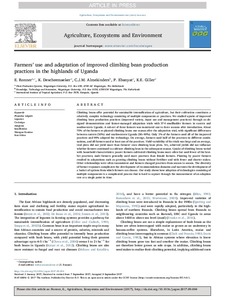| dc.contributor.author | Ronner, E. |
| dc.contributor.author | Descheemaeker, Katrien |
| dc.contributor.author | Almekinders, Conny J.M. |
| dc.contributor.author | Ebanyat, Peter |
| dc.contributor.author | Giller, Ken E. |
| dc.date.accessioned | 2019-12-04T11:11:30Z |
| dc.date.available | 2019-12-04T11:11:30Z |
| dc.date.issued | 2018 |
| dc.identifier.citation | Ronner, E., Descheemaeker, K., Almekinders, C.J.M., Ebanyat, P. & Giller, K.E. (2018). Farmers’ use and adaptation of improved climbing bean production practices in the highlands of Uganda. Agriculture, Ecosystems & Environment, 261, 186-200. |
| dc.identifier.issn | 0167-8809 |
| dc.identifier.uri | https://hdl.handle.net/20.500.12478/2442 |
| dc.description | Open Access Article; Published online: 28 Sept 2017 |
| dc.description.abstract | Climbing beans offer potential for sustainable intensification of agriculture, but their cultivation constitutes a relatively complex technology consisting of multiple components or practices. We studied uptake of improved climbing bean production practices (improved variety, input use and management practices) through co-designed demonstrations and farmer-managed adaptation trials with 374 smallholder farmers in eastern and southwestern Uganda. A sub-set of these farmers was monitored one to three seasons after introduction. About 70% of the farmers re-planted climbing beans one season after the adaptation trial, with significant differences between eastern (50%) and southwestern Uganda (80–90%). Only 1% of the farmers used all of the improved practices and 99% adapted the technology. On average, farmers used half of the practices in different combinations, and all farmers used at least one of the practices. Yield variability of the trials was large and on average, trial plots did not yield more than farmers’ own climbing bean plots. Yet, achieved yields did not influence whether farmers continued to cultivate climbing bean in the subsequent season. Uptake of climbing beans varied with household characteristics: poorer farmers cultivated climbing beans more often but used fewer of the best-bet practices; male farmers generally used more practices than female farmers. Planting by poorer farmers resulted in adaptations such as growing climbing beans without fertilizer and with fewer and shorter stakes. Other relationships were often inconsistent and farmers changed practices from season to season. The diversity of farmer responses complicates the development of recommendation domains and warrants the development of a basket of options from which farmers can choose. Our study shows how adoption of technologies consisting of multiple components is a complicated process that is hard to capture through the measurement of an adoption rate at a single point in time. |
| dc.description.sponsorship | Bill & Melinda Gates Foundation |
| dc.format.extent | 186-200 |
| dc.language.iso | en |
| dc.subject | Phaseolus Vulgaris |
| dc.subject | Legumes |
| dc.subject | Smallholders |
| dc.subject | Nitrogen Fixation |
| dc.subject | Climbing Beans |
| dc.title | Farmers’ use and adaptation of improved climbing bean production practices in the highlands of Uganda |
| dc.type | Journal Article |
| dc.description.version | Peer Review |
| cg.contributor.crp | Climate Change, Agriculture and Food Security |
| cg.contributor.crp | Grain Legumes |
| cg.contributor.affiliation | Wageningen University and Research Centre |
| cg.contributor.affiliation | International Institute of Tropical Agriculture |
| cg.coverage.region | Africa |
| cg.coverage.region | East Africa |
| cg.coverage.country | Uganda |
| cg.creator.identifier | Ken E Giller: 0000-0002-5998-4652 |
| cg.isijournal | ISI Journal |
| cg.authorship.types | CGIAR and advanced research institute |
| cg.iitasubject | Grain Legumes |
| cg.iitasubject | Plant Production |
| cg.journal | Agriculture, Ecosystems & Environment |
| cg.howpublished | Formally Published |
| cg.accessibilitystatus | Open Access |
| local.dspaceid | 93020 |
| cg.targetaudience | Scientists |
| cg.identifier.doi | http://dx.doi.org/10.1016/j.agee.2017.09.004 |

